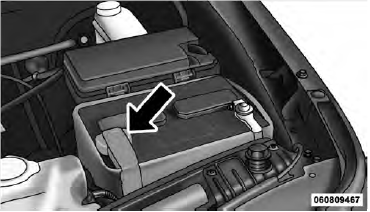 Dodge Nitro: Jump-starting procedures
Dodge Nitro: Jump-starting procedures
If your vehicle has a discharged battery it can be jumpstarted using a set of jumper cables and a battery in another vehicle or by using a portable battery booster pack. Jump-starting can be dangerous if done improperly so please follow the procedures in this section carefully.
NOTE: When using a portable battery booster pack follow the manufacturer’s operating instructions and precautions.
CAUTION: Do not use a portable battery booster pack or any other booster source with a system voltage greater than 12 Volts or damage to the battery, starter motor, alternator or electrical system may occur.
WARNING: Do not attempt jump-starting if the battery is frozen. It could rupture or explode and cause personal injury.
Preparations for Jump-Start
The battery in your vehicle is located in the front of the engine compartment, behind the left headlight assembly.
NOTE: The positive battery post is covered with a protective cap. Lift up on the cap to gain access to the positive battery post.
 Positive Battery Post
Positive Battery Post
WARNING:
• Take care to avoid the radiator cooling fan whenever
the hood is raised. It can start anytime the
ignition switch is on. You can be injured by
moving fan blades.
• Remove any metal jewelry such as watch bands or
bracelets that might make an inadvertent electrical
contact. You could be seriously injured.
• Batteries contain sulfuric acid that can burn your
skin or eyes and generate hydrogen gas which is
flammable and explosive. Keep open flames or
sparks away from the battery.
1. Set the parking brake, shift the automatic transmission into PARK and turn the ignition to LOCK. 2. Turn off the heater, radio, and all unnecessary electrical accessories. 3. If using another vehicle to jump-start the battery, park the vehicle within the jumper cables reach, set the parking brake and make sure the ignition is OFF.
WARNING: Do not allow vehicles to touch each other as this could establish a ground connection and personal injury could result.
Jump-Starting Procedure
WARNING: Failure to follow this procedure could result in personal injury or property damage due to battery explosion.
CAUTION: Failure to follow these procedures could result in damage to the charging system of the booster vehicle or the discharged vehicle.
1. Connect the positive (+) end of the jumper cable to the positive (+) post of the discharged vehicle. 2. Connect the opposite end of the positive (+) jumper cable to the positive (+) post of the booster battery. 3. Connect the negative end (-) of the jumper cable to the negative (-) post of the booster battery. 4. Connect the opposite end of the negative (-) jumper cable to a good engine ground (exposed metal part of the discharged vehicle’s engine) away from the battery and the fuel injection system.
WARNING: Do not connect the cable to the negative post (-) of the discharged battery. The resulting electrical spark could cause the battery to explode and could result in personal injury.
5. Start the engine in the vehicle that has the booster battery, let the engine idle a few minutes, and then start the engine in the vehicle with the discharged battery. Once the engine is started, remove the jumper cables in the reverse sequence: 6. Disconnect the negative (-) jumper cable from the engine ground of the vehicle with the discharged battery. 7. Disconnect the negative end (-) of the jumper cable from the negative (-) post of the booster battery.
8. Disconnect the opposite end of the positive (+) jumper cable from the positive (+) post of the booster battery. 9. Disconnect the positive (+) end of the jumper cable from the positive (+) post of the discharged vehicle. If frequent jump-starting is required to start your vehicle you should have the battery and charging system inspected at your authorized dealer.
CAUTION: Accessories that can be plugged into the vehicle power outlets draw power from the vehicle’s battery, even when not in use (i.e., cellular phones, etc.). Eventually, if plugged in long enough, the vehicle’s battery will discharge sufficiently to degrade battery life and/or prevent the engine from starting.
 Jacking and tire changing
Jacking and tire changing
WARNING:
• Getting under a jacked-up vehicle is dangerous.
The vehicle could slip off the jack and fall on you.
You could be crushed. Never get any part of your
body under a vehicle that is ...
 Towing a disabled vehicle
Towing a disabled vehicle
Proper towing or lifting equipment is required to prevent
damage to your vehicle. Use of safety chains is recommended.
Attach towing device to main structural members
of the vehicle, not to bump ...
See also:
Setting the vehicle speed
Press the “ON-OFF” button to
activate the cruise control.
Cruise control indicator will
come on.
Press the button again to
deactivate the cruise control.
Accelerate or decelerate the
...
Brake PadWear Indicators
The front and rear disc brakes on all
models have audible brake wear
indicators.
If the brake pads need replacing, you
will hear a distinctive, metallic
screeching sound when you apply
the ...
Playing the XM Radio
On EX-L without Navigation System
Your vehicle is capable of receiving
XM Radio anywhere in Canada and
the United States, except Hawaii,
Alaska, and Puerto Rico. XM
CANADA is a registered bus ...
